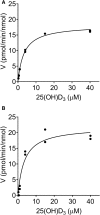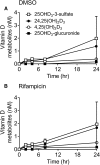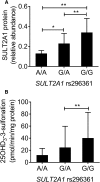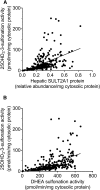Polymorphic Human Sulfotransferase 2A1 Mediates the Formation of 25-Hydroxyvitamin D3-3- O-Sulfate, a Major Circulating Vitamin D Metabolite in Humans
- PMID: 29343609
- PMCID: PMC5829543
- DOI: 10.1124/dmd.117.078428
Polymorphic Human Sulfotransferase 2A1 Mediates the Formation of 25-Hydroxyvitamin D3-3- O-Sulfate, a Major Circulating Vitamin D Metabolite in Humans
Abstract
Metabolism of 25-hydroxyvitamin D3 (25OHD3) plays a central role in regulating the biologic effects of vitamin D in the body. Although cytochrome P450-dependent hydroxylation of 25OHD3 has been extensively investigated, limited information is available on the conjugation of 25OHD3 In this study, we report that 25OHD3 is selectively conjugated to 25OHD3-3-O-sulfate by human sulfotransferase 2A1 (SULT2A1) and that the liver is a primary site of metabolite formation. At a low (50 nM) concentration of 25OHD3, 25OHD3-3-O-sulfate was the most abundant metabolite, with an intrinsic clearance approximately 8-fold higher than the next most efficient metabolic route. In addition, 25OHD3 sulfonation was not inducible by the potent human pregnane X receptor agonist, rifampicin. The 25OHD3 sulfonation rates in a bank of 258 different human liver cytosols were highly variable but correlated with the rates of dehydroepiandrosterone sulfonation. Further analysis revealed a significant association between a common single nucleotide variant within intron 1 of SULT2A1 (rs296361; minor allele frequency = 15% in whites) and liver cytosolic SULT2A1 content as well as 25OHD3-3-O-sulfate formation rate, suggesting that variation in the SULT2A1 gene contributes importantly to interindividual differences in vitamin D homeostasis. Finally, 25OHD3-3-O-sulfate exhibited high affinity for the vitamin D binding protein and was detectable in human plasma and bile but not in urine samples. Thus, circulating concentrations of 25OHD3-3-O-sulfate appear to be protected from rapid renal elimination, raising the possibility that the sulfate metabolite may serve as a reservoir of 25OHD3 in vivo, and contribute indirectly to the biologic effects of vitamin D.
Copyright © 2018 by The American Society for Pharmacology and Experimental Therapeutics.
Figures








Similar articles
-
3-Epi-25-hydroxyvitamin D3 is a poor substrate for SULT2A1: Analysis of its 3-sulfate in cord plasma and recombinant human SULT2A1 incubate.Steroids. 2020 Oct;162:108695. doi: 10.1016/j.steroids.2020.108695. Epub 2020 Jul 7. Steroids. 2020. PMID: 32649998
-
Sulfation of vitamin D3 -related compounds-identification and characterization of the responsible human cytosolic sulfotransferases.FEBS Lett. 2017 Aug;591(16):2417-2425. doi: 10.1002/1873-3468.12767. Epub 2017 Aug 9. FEBS Lett. 2017. PMID: 28746983
-
Development of a LC-MS/MS method to measure serum 3-sulfate and 3-glucuronide 25-hydroxyvitamin D3 metabolites; comparisons to unconjugated 25OHD in pregnancy and polycystic ovary syndrome.Steroids. 2021 May;169:108812. doi: 10.1016/j.steroids.2021.108812. Epub 2021 Feb 23. Steroids. 2021. PMID: 33636208
-
Vitamin D receptor regulation of the steroid/bile acid sulfotransferase SULT2A1.Methods Enzymol. 2005;400:165-91. doi: 10.1016/S0076-6879(05)00010-8. Methods Enzymol. 2005. PMID: 16399349 Review.
-
Eight cytochrome P450s catalyze vitamin D metabolism.Front Biosci. 2004 Sep 1;9:3007-18. doi: 10.2741/1455. Front Biosci. 2004. PMID: 15353333 Review.
Cited by
-
Genome-wide association study identifies 143 loci associated with 25 hydroxyvitamin D concentration.Nat Commun. 2020 Apr 2;11(1):1647. doi: 10.1038/s41467-020-15421-7. Nat Commun. 2020. PMID: 32242144 Free PMC article.
-
Separation and identification of monoglucuronides of vitamin D3 metabolites in urine by derivatization-assisted LC/ESI-MS/MS using a new Cookson-type reagent.Anal Sci. 2023 Jul;39(7):1053-1063. doi: 10.1007/s44211-023-00350-4. Epub 2023 May 2. Anal Sci. 2023. PMID: 37131118
-
Simultaneous determination of vitamin D metabolites 25(OH)D3 and 1α,25(OH)2D3 in human plasma using liquid chromatography tandem mass spectrometry.J Mass Spectrom Adv Clin Lab. 2022 Apr 23;24:65-79. doi: 10.1016/j.jmsacl.2022.04.001. eCollection 2022 Apr. J Mass Spectrom Adv Clin Lab. 2022. PMID: 35572785 Free PMC article.
-
Hepatic Transport of 25-Hydroxyvitamin D3 Conjugates: A Mechanism of 25-Hydroxyvitamin D3 Delivery to the Intestinal Tract.Drug Metab Dispos. 2018 May;46(5):581-591. doi: 10.1124/dmd.117.078881. Epub 2018 Feb 21. Drug Metab Dispos. 2018. PMID: 29467214 Free PMC article.
-
Genetic Determinants of 25-Hydroxyvitamin D Concentrations and Their Relevance to Public Health.Nutrients. 2022 Oct 20;14(20):4408. doi: 10.3390/nu14204408. Nutrients. 2022. PMID: 36297091 Free PMC article. Review.
References
Publication types
MeSH terms
Substances
Grants and funding
LinkOut - more resources
Full Text Sources
Other Literature Sources
Medical

